Getting Extinct Species Back to Life through Cloning
VerifiedAdded on 2023/01/23
|10
|2427
|27
AI Summary
This article discusses the technical procedures associated with cloning, the importance of cross breeding, and the pros and cons of bringing extinct species back to life. It also explores the potential health hazards and the implications of this research.
Contribute Materials
Your contribution can guide someone’s learning journey. Share your
documents today.
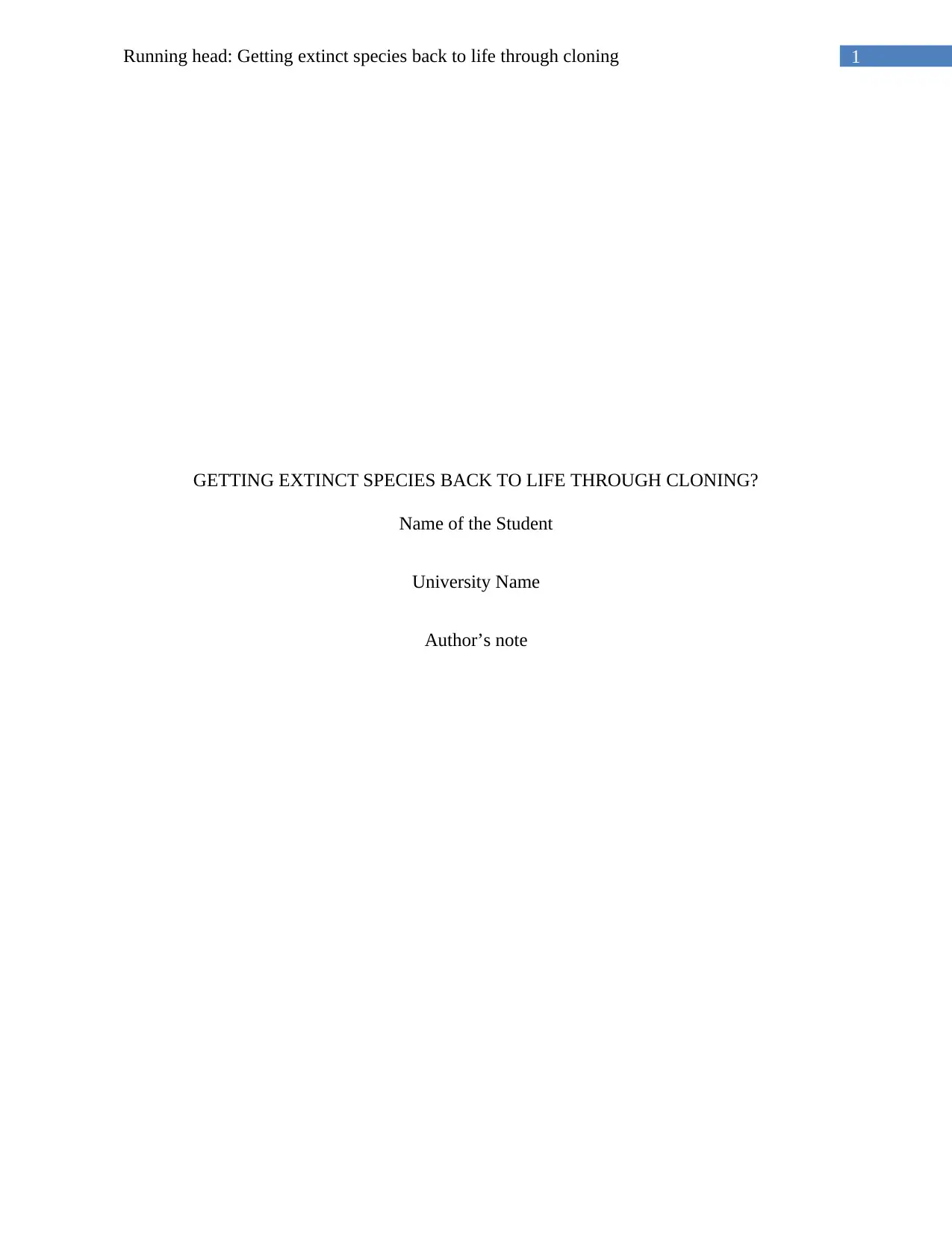
1Running head: Getting extinct species back to life through cloning
GETTING EXTINCT SPECIES BACK TO LIFE THROUGH CLONING?
Name of the Student
University Name
Author’s note
GETTING EXTINCT SPECIES BACK TO LIFE THROUGH CLONING?
Name of the Student
University Name
Author’s note
Secure Best Marks with AI Grader
Need help grading? Try our AI Grader for instant feedback on your assignments.
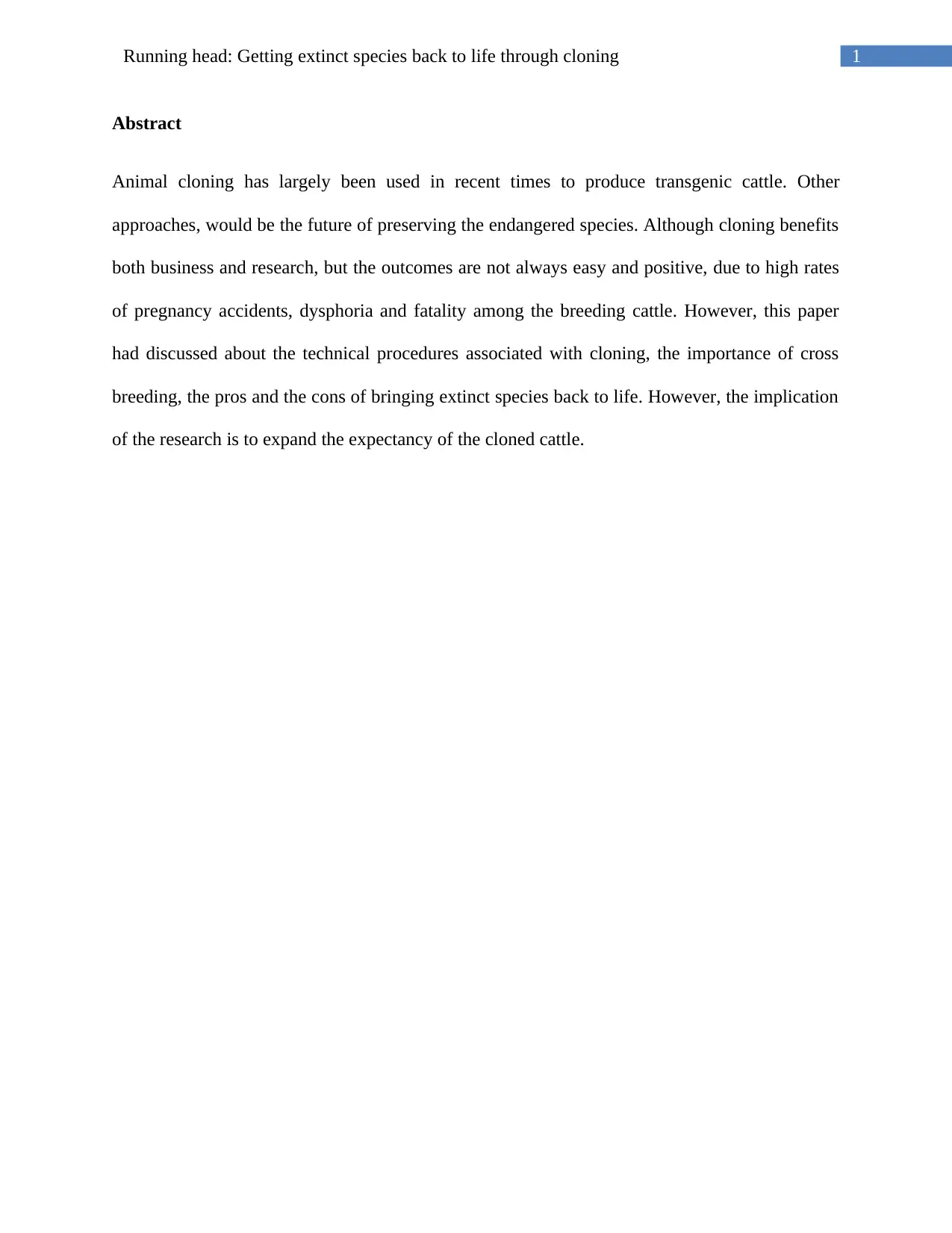
1Running head: Getting extinct species back to life through cloning
Abstract
Animal cloning has largely been used in recent times to produce transgenic cattle. Other
approaches, would be the future of preserving the endangered species. Although cloning benefits
both business and research, but the outcomes are not always easy and positive, due to high rates
of pregnancy accidents, dysphoria and fatality among the breeding cattle. However, this paper
had discussed about the technical procedures associated with cloning, the importance of cross
breeding, the pros and the cons of bringing extinct species back to life. However, the implication
of the research is to expand the expectancy of the cloned cattle.
Abstract
Animal cloning has largely been used in recent times to produce transgenic cattle. Other
approaches, would be the future of preserving the endangered species. Although cloning benefits
both business and research, but the outcomes are not always easy and positive, due to high rates
of pregnancy accidents, dysphoria and fatality among the breeding cattle. However, this paper
had discussed about the technical procedures associated with cloning, the importance of cross
breeding, the pros and the cons of bringing extinct species back to life. However, the implication
of the research is to expand the expectancy of the cloned cattle.

2Running head: Getting extinct species back to life through cloning
Table of Contents
GETTING EXTINCT SPECIES BACK TO LIFE THROUGH CLONING?................................1
Getting extinct species back to life through cloning?......................................................................3
Discussion........................................................................................................................................3
Technical procedures...................................................................................................................3
Recovery of endangered animals.................................................................................................5
Disadvantages an advantages of bringing back the extinct species.................................................6
Potential health hazards...............................................................................................................7
Neonatal health problems............................................................................................................7
Conclusion.......................................................................................................................................7
References........................................................................................................................................8
Table of Contents
GETTING EXTINCT SPECIES BACK TO LIFE THROUGH CLONING?................................1
Getting extinct species back to life through cloning?......................................................................3
Discussion........................................................................................................................................3
Technical procedures...................................................................................................................3
Recovery of endangered animals.................................................................................................5
Disadvantages an advantages of bringing back the extinct species.................................................6
Potential health hazards...............................................................................................................7
Neonatal health problems............................................................................................................7
Conclusion.......................................................................................................................................7
References........................................................................................................................................8
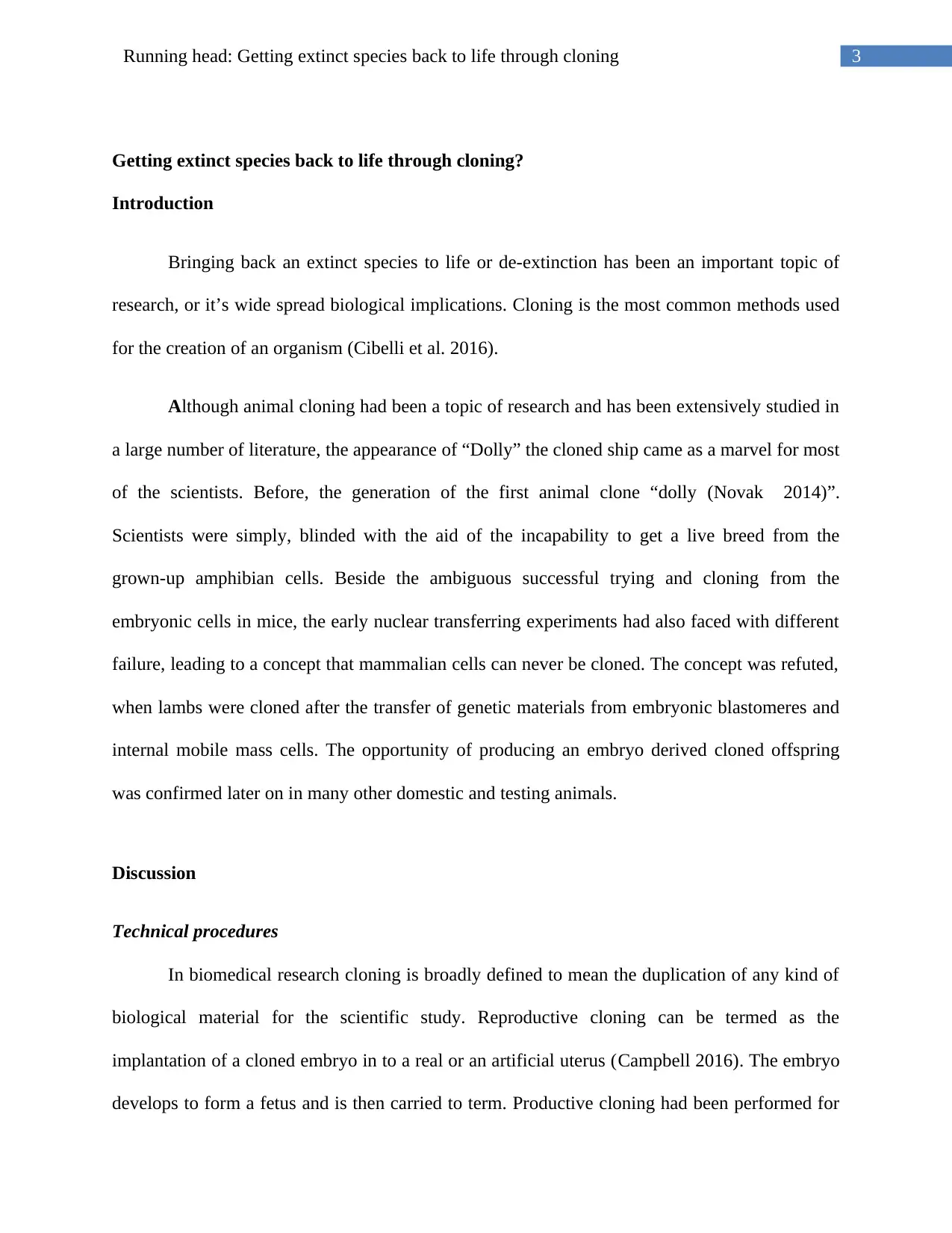
3Running head: Getting extinct species back to life through cloning
Getting extinct species back to life through cloning?
Introduction
Bringing back an extinct species to life or de-extinction has been an important topic of
research, or it’s wide spread biological implications. Cloning is the most common methods used
for the creation of an organism (Cibelli et al. 2016).
Although animal cloning had been a topic of research and has been extensively studied in
a large number of literature, the appearance of “Dolly” the cloned ship came as a marvel for most
of the scientists. Before, the generation of the first animal clone “dolly (Novak 2014)”.
Scientists were simply, blinded with the aid of the incapability to get a live breed from the
grown-up amphibian cells. Beside the ambiguous successful trying and cloning from the
embryonic cells in mice, the early nuclear transferring experiments had also faced with different
failure, leading to a concept that mammalian cells can never be cloned. The concept was refuted,
when lambs were cloned after the transfer of genetic materials from embryonic blastomeres and
internal mobile mass cells. The opportunity of producing an embryo derived cloned offspring
was confirmed later on in many other domestic and testing animals.
Discussion
Technical procedures
In biomedical research cloning is broadly defined to mean the duplication of any kind of
biological material for the scientific study. Reproductive cloning can be termed as the
implantation of a cloned embryo in to a real or an artificial uterus (Campbell 2016). The embryo
develops to form a fetus and is then carried to term. Productive cloning had been performed for
Getting extinct species back to life through cloning?
Introduction
Bringing back an extinct species to life or de-extinction has been an important topic of
research, or it’s wide spread biological implications. Cloning is the most common methods used
for the creation of an organism (Cibelli et al. 2016).
Although animal cloning had been a topic of research and has been extensively studied in
a large number of literature, the appearance of “Dolly” the cloned ship came as a marvel for most
of the scientists. Before, the generation of the first animal clone “dolly (Novak 2014)”.
Scientists were simply, blinded with the aid of the incapability to get a live breed from the
grown-up amphibian cells. Beside the ambiguous successful trying and cloning from the
embryonic cells in mice, the early nuclear transferring experiments had also faced with different
failure, leading to a concept that mammalian cells can never be cloned. The concept was refuted,
when lambs were cloned after the transfer of genetic materials from embryonic blastomeres and
internal mobile mass cells. The opportunity of producing an embryo derived cloned offspring
was confirmed later on in many other domestic and testing animals.
Discussion
Technical procedures
In biomedical research cloning is broadly defined to mean the duplication of any kind of
biological material for the scientific study. Reproductive cloning can be termed as the
implantation of a cloned embryo in to a real or an artificial uterus (Campbell 2016). The embryo
develops to form a fetus and is then carried to term. Productive cloning had been performed for
Secure Best Marks with AI Grader
Need help grading? Try our AI Grader for instant feedback on your assignments.
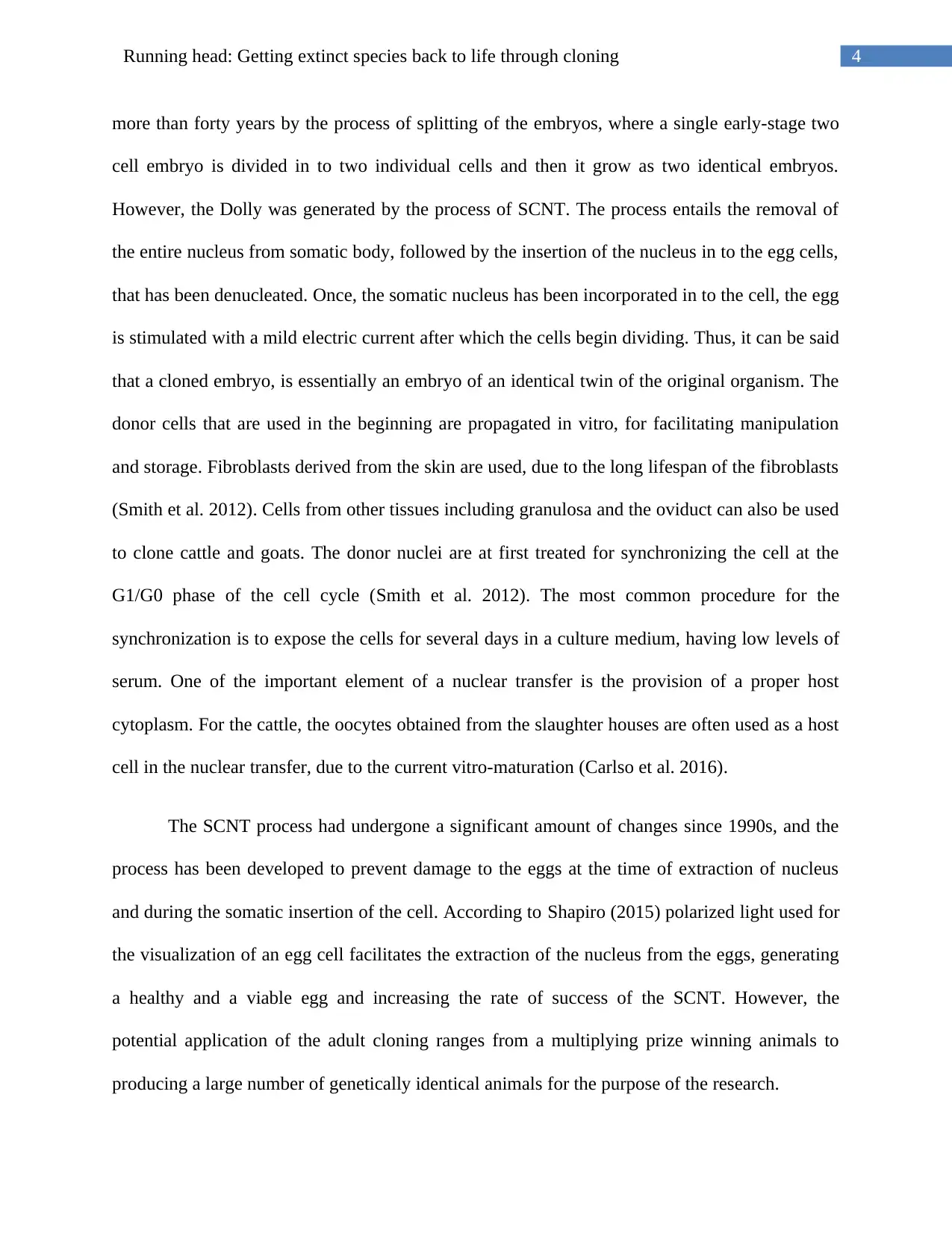
4Running head: Getting extinct species back to life through cloning
more than forty years by the process of splitting of the embryos, where a single early-stage two
cell embryo is divided in to two individual cells and then it grow as two identical embryos.
However, the Dolly was generated by the process of SCNT. The process entails the removal of
the entire nucleus from somatic body, followed by the insertion of the nucleus in to the egg cells,
that has been denucleated. Once, the somatic nucleus has been incorporated in to the cell, the egg
is stimulated with a mild electric current after which the cells begin dividing. Thus, it can be said
that a cloned embryo, is essentially an embryo of an identical twin of the original organism. The
donor cells that are used in the beginning are propagated in vitro, for facilitating manipulation
and storage. Fibroblasts derived from the skin are used, due to the long lifespan of the fibroblasts
(Smith et al. 2012). Cells from other tissues including granulosa and the oviduct can also be used
to clone cattle and goats. The donor nuclei are at first treated for synchronizing the cell at the
G1/G0 phase of the cell cycle (Smith et al. 2012). The most common procedure for the
synchronization is to expose the cells for several days in a culture medium, having low levels of
serum. One of the important element of a nuclear transfer is the provision of a proper host
cytoplasm. For the cattle, the oocytes obtained from the slaughter houses are often used as a host
cell in the nuclear transfer, due to the current vitro-maturation (Carlso et al. 2016).
The SCNT process had undergone a significant amount of changes since 1990s, and the
process has been developed to prevent damage to the eggs at the time of extraction of nucleus
and during the somatic insertion of the cell. According to Shapiro (2015) polarized light used for
the visualization of an egg cell facilitates the extraction of the nucleus from the eggs, generating
a healthy and a viable egg and increasing the rate of success of the SCNT. However, the
potential application of the adult cloning ranges from a multiplying prize winning animals to
producing a large number of genetically identical animals for the purpose of the research.
more than forty years by the process of splitting of the embryos, where a single early-stage two
cell embryo is divided in to two individual cells and then it grow as two identical embryos.
However, the Dolly was generated by the process of SCNT. The process entails the removal of
the entire nucleus from somatic body, followed by the insertion of the nucleus in to the egg cells,
that has been denucleated. Once, the somatic nucleus has been incorporated in to the cell, the egg
is stimulated with a mild electric current after which the cells begin dividing. Thus, it can be said
that a cloned embryo, is essentially an embryo of an identical twin of the original organism. The
donor cells that are used in the beginning are propagated in vitro, for facilitating manipulation
and storage. Fibroblasts derived from the skin are used, due to the long lifespan of the fibroblasts
(Smith et al. 2012). Cells from other tissues including granulosa and the oviduct can also be used
to clone cattle and goats. The donor nuclei are at first treated for synchronizing the cell at the
G1/G0 phase of the cell cycle (Smith et al. 2012). The most common procedure for the
synchronization is to expose the cells for several days in a culture medium, having low levels of
serum. One of the important element of a nuclear transfer is the provision of a proper host
cytoplasm. For the cattle, the oocytes obtained from the slaughter houses are often used as a host
cell in the nuclear transfer, due to the current vitro-maturation (Carlso et al. 2016).
The SCNT process had undergone a significant amount of changes since 1990s, and the
process has been developed to prevent damage to the eggs at the time of extraction of nucleus
and during the somatic insertion of the cell. According to Shapiro (2015) polarized light used for
the visualization of an egg cell facilitates the extraction of the nucleus from the eggs, generating
a healthy and a viable egg and increasing the rate of success of the SCNT. However, the
potential application of the adult cloning ranges from a multiplying prize winning animals to
producing a large number of genetically identical animals for the purpose of the research.
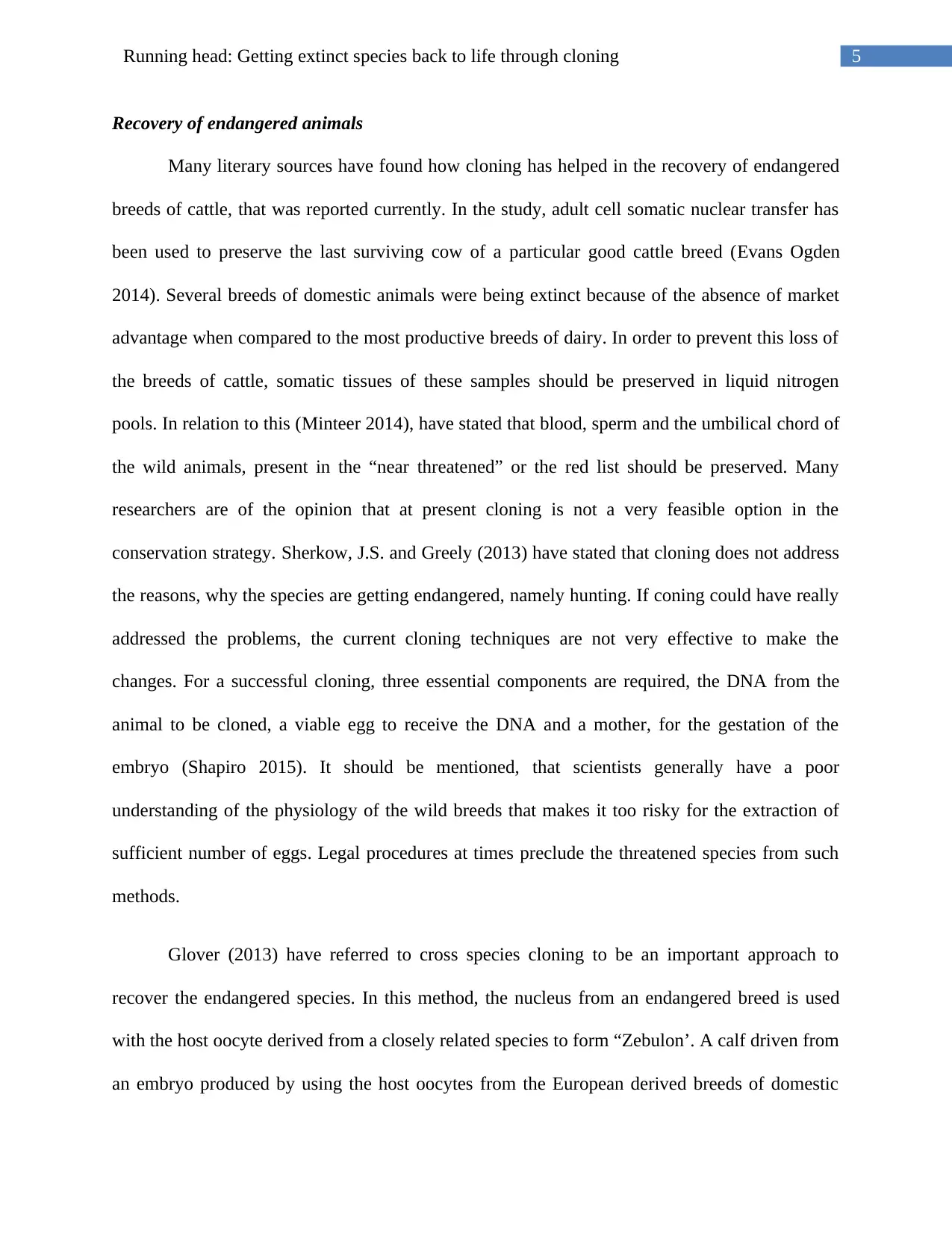
5Running head: Getting extinct species back to life through cloning
Recovery of endangered animals
Many literary sources have found how cloning has helped in the recovery of endangered
breeds of cattle, that was reported currently. In the study, adult cell somatic nuclear transfer has
been used to preserve the last surviving cow of a particular good cattle breed (Evans Ogden
2014). Several breeds of domestic animals were being extinct because of the absence of market
advantage when compared to the most productive breeds of dairy. In order to prevent this loss of
the breeds of cattle, somatic tissues of these samples should be preserved in liquid nitrogen
pools. In relation to this (Minteer 2014), have stated that blood, sperm and the umbilical chord of
the wild animals, present in the “near threatened” or the red list should be preserved. Many
researchers are of the opinion that at present cloning is not a very feasible option in the
conservation strategy. Sherkow, J.S. and Greely (2013) have stated that cloning does not address
the reasons, why the species are getting endangered, namely hunting. If coning could have really
addressed the problems, the current cloning techniques are not very effective to make the
changes. For a successful cloning, three essential components are required, the DNA from the
animal to be cloned, a viable egg to receive the DNA and a mother, for the gestation of the
embryo (Shapiro 2015). It should be mentioned, that scientists generally have a poor
understanding of the physiology of the wild breeds that makes it too risky for the extraction of
sufficient number of eggs. Legal procedures at times preclude the threatened species from such
methods.
Glover (2013) have referred to cross species cloning to be an important approach to
recover the endangered species. In this method, the nucleus from an endangered breed is used
with the host oocyte derived from a closely related species to form “Zebulon’. A calf driven from
an embryo produced by using the host oocytes from the European derived breeds of domestic
Recovery of endangered animals
Many literary sources have found how cloning has helped in the recovery of endangered
breeds of cattle, that was reported currently. In the study, adult cell somatic nuclear transfer has
been used to preserve the last surviving cow of a particular good cattle breed (Evans Ogden
2014). Several breeds of domestic animals were being extinct because of the absence of market
advantage when compared to the most productive breeds of dairy. In order to prevent this loss of
the breeds of cattle, somatic tissues of these samples should be preserved in liquid nitrogen
pools. In relation to this (Minteer 2014), have stated that blood, sperm and the umbilical chord of
the wild animals, present in the “near threatened” or the red list should be preserved. Many
researchers are of the opinion that at present cloning is not a very feasible option in the
conservation strategy. Sherkow, J.S. and Greely (2013) have stated that cloning does not address
the reasons, why the species are getting endangered, namely hunting. If coning could have really
addressed the problems, the current cloning techniques are not very effective to make the
changes. For a successful cloning, three essential components are required, the DNA from the
animal to be cloned, a viable egg to receive the DNA and a mother, for the gestation of the
embryo (Shapiro 2015). It should be mentioned, that scientists generally have a poor
understanding of the physiology of the wild breeds that makes it too risky for the extraction of
sufficient number of eggs. Legal procedures at times preclude the threatened species from such
methods.
Glover (2013) have referred to cross species cloning to be an important approach to
recover the endangered species. In this method, the nucleus from an endangered breed is used
with the host oocyte derived from a closely related species to form “Zebulon’. A calf driven from
an embryo produced by using the host oocytes from the European derived breeds of domestic
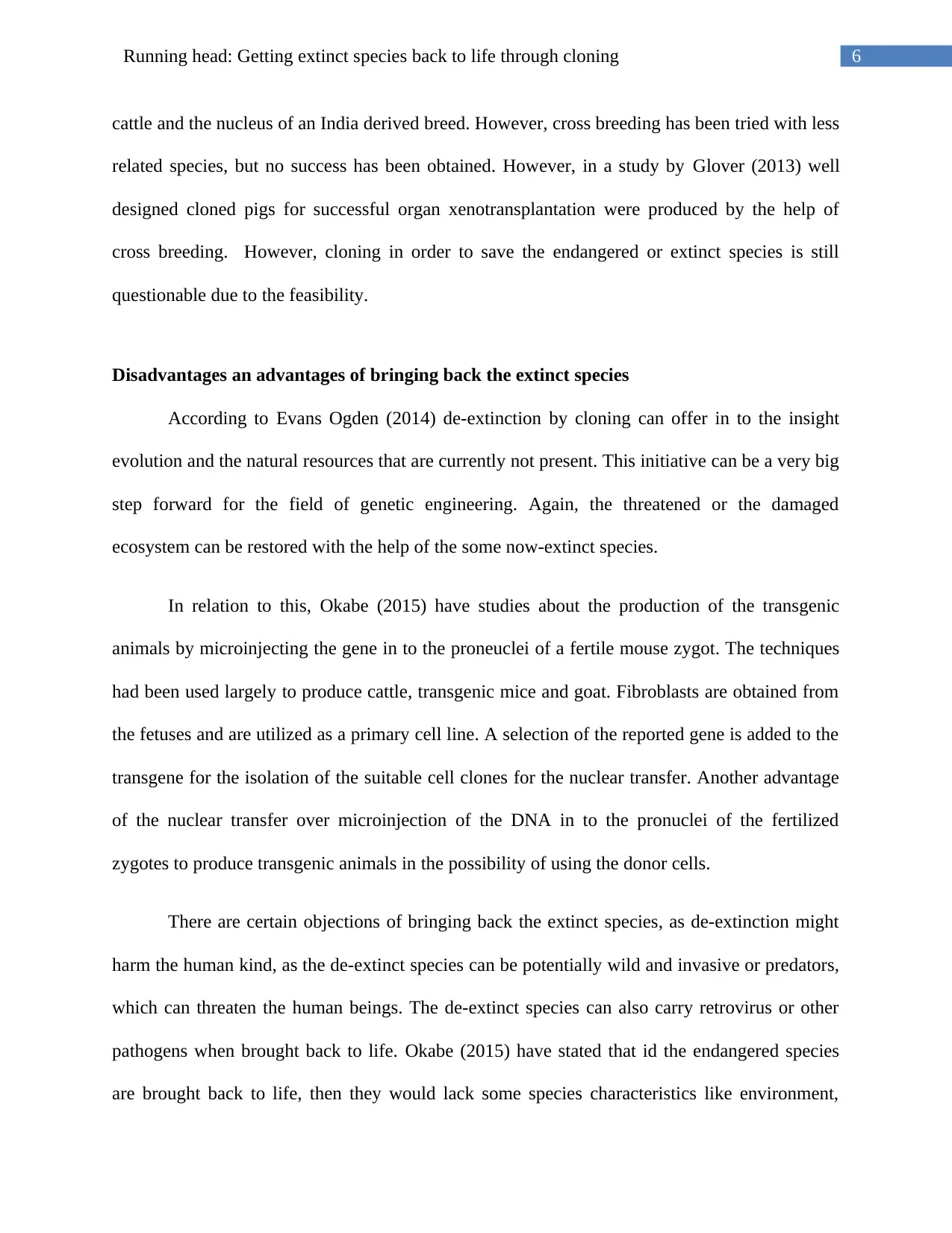
6Running head: Getting extinct species back to life through cloning
cattle and the nucleus of an India derived breed. However, cross breeding has been tried with less
related species, but no success has been obtained. However, in a study by Glover (2013) well
designed cloned pigs for successful organ xenotransplantation were produced by the help of
cross breeding. However, cloning in order to save the endangered or extinct species is still
questionable due to the feasibility.
Disadvantages an advantages of bringing back the extinct species
According to Evans Ogden (2014) de-extinction by cloning can offer in to the insight
evolution and the natural resources that are currently not present. This initiative can be a very big
step forward for the field of genetic engineering. Again, the threatened or the damaged
ecosystem can be restored with the help of the some now-extinct species.
In relation to this, Okabe (2015) have studies about the production of the transgenic
animals by microinjecting the gene in to the proneuclei of a fertile mouse zygot. The techniques
had been used largely to produce cattle, transgenic mice and goat. Fibroblasts are obtained from
the fetuses and are utilized as a primary cell line. A selection of the reported gene is added to the
transgene for the isolation of the suitable cell clones for the nuclear transfer. Another advantage
of the nuclear transfer over microinjection of the DNA in to the pronuclei of the fertilized
zygotes to produce transgenic animals in the possibility of using the donor cells.
There are certain objections of bringing back the extinct species, as de-extinction might
harm the human kind, as the de-extinct species can be potentially wild and invasive or predators,
which can threaten the human beings. The de-extinct species can also carry retrovirus or other
pathogens when brought back to life. Okabe (2015) have stated that id the endangered species
are brought back to life, then they would lack some species characteristics like environment,
cattle and the nucleus of an India derived breed. However, cross breeding has been tried with less
related species, but no success has been obtained. However, in a study by Glover (2013) well
designed cloned pigs for successful organ xenotransplantation were produced by the help of
cross breeding. However, cloning in order to save the endangered or extinct species is still
questionable due to the feasibility.
Disadvantages an advantages of bringing back the extinct species
According to Evans Ogden (2014) de-extinction by cloning can offer in to the insight
evolution and the natural resources that are currently not present. This initiative can be a very big
step forward for the field of genetic engineering. Again, the threatened or the damaged
ecosystem can be restored with the help of the some now-extinct species.
In relation to this, Okabe (2015) have studies about the production of the transgenic
animals by microinjecting the gene in to the proneuclei of a fertile mouse zygot. The techniques
had been used largely to produce cattle, transgenic mice and goat. Fibroblasts are obtained from
the fetuses and are utilized as a primary cell line. A selection of the reported gene is added to the
transgene for the isolation of the suitable cell clones for the nuclear transfer. Another advantage
of the nuclear transfer over microinjection of the DNA in to the pronuclei of the fertilized
zygotes to produce transgenic animals in the possibility of using the donor cells.
There are certain objections of bringing back the extinct species, as de-extinction might
harm the human kind, as the de-extinct species can be potentially wild and invasive or predators,
which can threaten the human beings. The de-extinct species can also carry retrovirus or other
pathogens when brought back to life. Okabe (2015) have stated that id the endangered species
are brought back to life, then they would lack some species characteristics like environment,
Paraphrase This Document
Need a fresh take? Get an instant paraphrase of this document with our AI Paraphraser
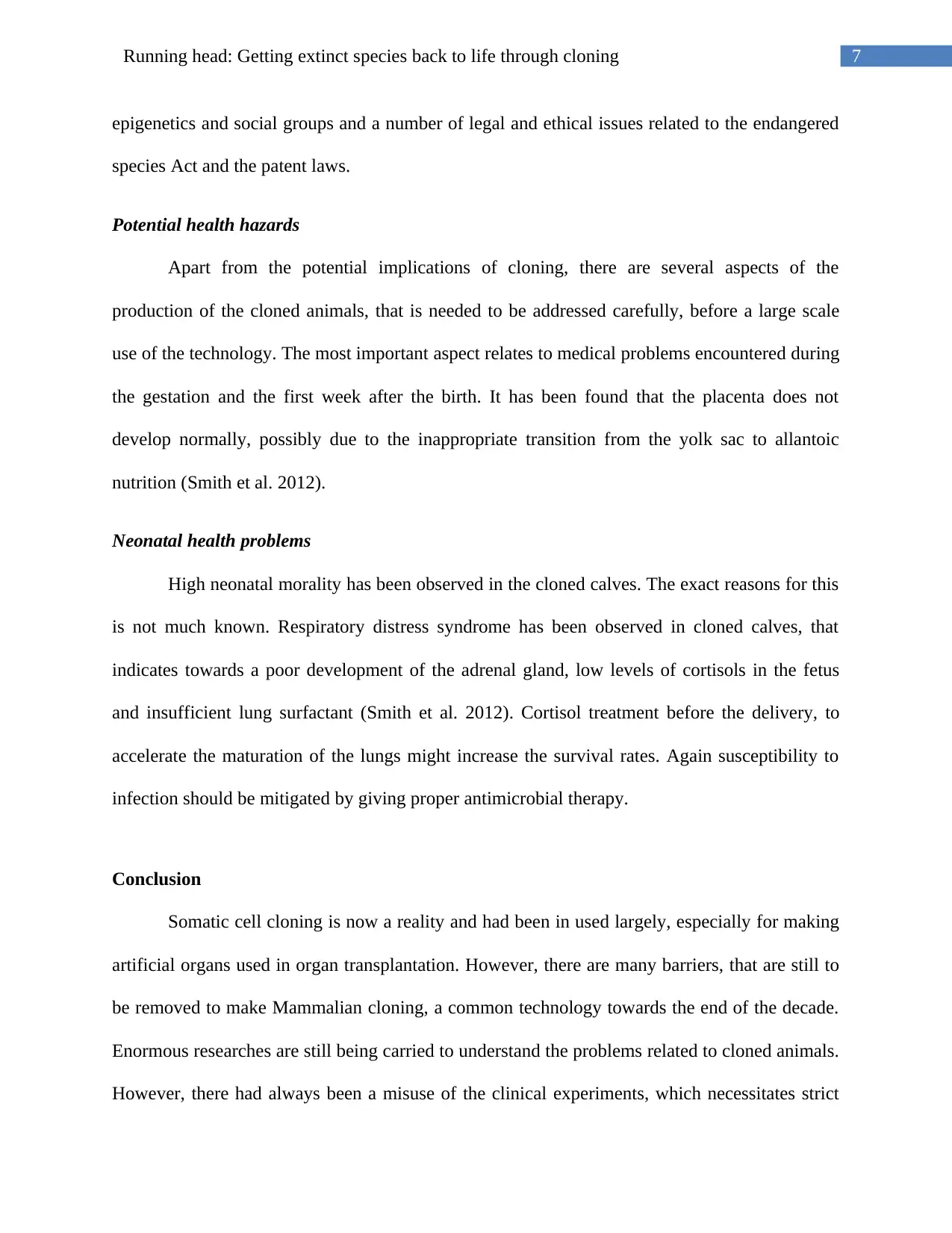
7Running head: Getting extinct species back to life through cloning
epigenetics and social groups and a number of legal and ethical issues related to the endangered
species Act and the patent laws.
Potential health hazards
Apart from the potential implications of cloning, there are several aspects of the
production of the cloned animals, that is needed to be addressed carefully, before a large scale
use of the technology. The most important aspect relates to medical problems encountered during
the gestation and the first week after the birth. It has been found that the placenta does not
develop normally, possibly due to the inappropriate transition from the yolk sac to allantoic
nutrition (Smith et al. 2012).
Neonatal health problems
High neonatal morality has been observed in the cloned calves. The exact reasons for this
is not much known. Respiratory distress syndrome has been observed in cloned calves, that
indicates towards a poor development of the adrenal gland, low levels of cortisols in the fetus
and insufficient lung surfactant (Smith et al. 2012). Cortisol treatment before the delivery, to
accelerate the maturation of the lungs might increase the survival rates. Again susceptibility to
infection should be mitigated by giving proper antimicrobial therapy.
Conclusion
Somatic cell cloning is now a reality and had been in used largely, especially for making
artificial organs used in organ transplantation. However, there are many barriers, that are still to
be removed to make Mammalian cloning, a common technology towards the end of the decade.
Enormous researches are still being carried to understand the problems related to cloned animals.
However, there had always been a misuse of the clinical experiments, which necessitates strict
epigenetics and social groups and a number of legal and ethical issues related to the endangered
species Act and the patent laws.
Potential health hazards
Apart from the potential implications of cloning, there are several aspects of the
production of the cloned animals, that is needed to be addressed carefully, before a large scale
use of the technology. The most important aspect relates to medical problems encountered during
the gestation and the first week after the birth. It has been found that the placenta does not
develop normally, possibly due to the inappropriate transition from the yolk sac to allantoic
nutrition (Smith et al. 2012).
Neonatal health problems
High neonatal morality has been observed in the cloned calves. The exact reasons for this
is not much known. Respiratory distress syndrome has been observed in cloned calves, that
indicates towards a poor development of the adrenal gland, low levels of cortisols in the fetus
and insufficient lung surfactant (Smith et al. 2012). Cortisol treatment before the delivery, to
accelerate the maturation of the lungs might increase the survival rates. Again susceptibility to
infection should be mitigated by giving proper antimicrobial therapy.
Conclusion
Somatic cell cloning is now a reality and had been in used largely, especially for making
artificial organs used in organ transplantation. However, there are many barriers, that are still to
be removed to make Mammalian cloning, a common technology towards the end of the decade.
Enormous researches are still being carried to understand the problems related to cloned animals.
However, there had always been a misuse of the clinical experiments, which necessitates strict
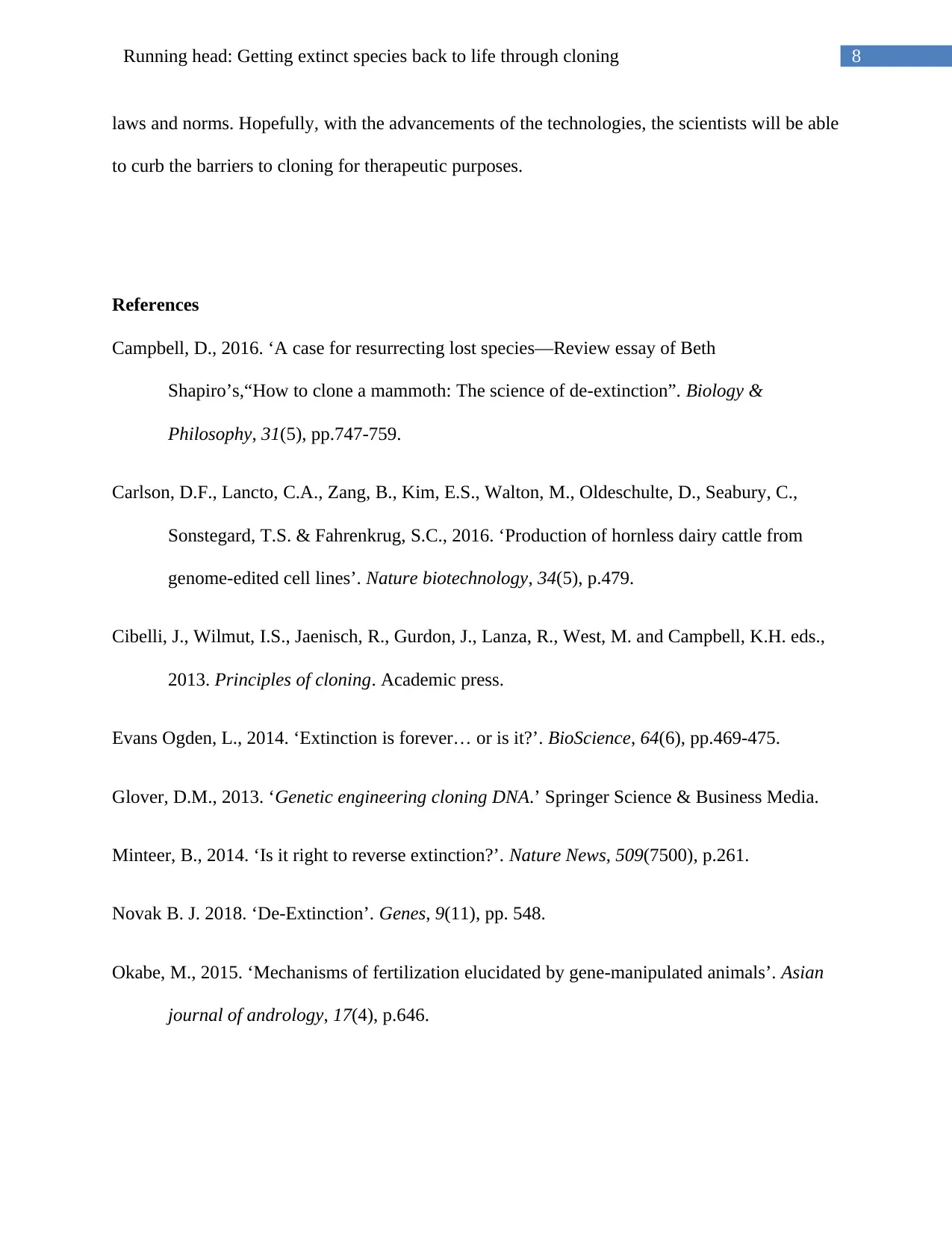
8Running head: Getting extinct species back to life through cloning
laws and norms. Hopefully, with the advancements of the technologies, the scientists will be able
to curb the barriers to cloning for therapeutic purposes.
References
Campbell, D., 2016. ‘A case for resurrecting lost species—Review essay of Beth
Shapiro’s,“How to clone a mammoth: The science of de-extinction”. Biology &
Philosophy, 31(5), pp.747-759.
Carlson, D.F., Lancto, C.A., Zang, B., Kim, E.S., Walton, M., Oldeschulte, D., Seabury, C.,
Sonstegard, T.S. & Fahrenkrug, S.C., 2016. ‘Production of hornless dairy cattle from
genome-edited cell lines’. Nature biotechnology, 34(5), p.479.
Cibelli, J., Wilmut, I.S., Jaenisch, R., Gurdon, J., Lanza, R., West, M. and Campbell, K.H. eds.,
2013. Principles of cloning. Academic press.
Evans Ogden, L., 2014. ‘Extinction is forever… or is it?’. BioScience, 64(6), pp.469-475.
Glover, D.M., 2013. ‘Genetic engineering cloning DNA.’ Springer Science & Business Media.
Minteer, B., 2014. ‘Is it right to reverse extinction?’. Nature News, 509(7500), p.261.
Novak B. J. 2018. ‘De-Extinction’. Genes, 9(11), pp. 548.
Okabe, M., 2015. ‘Mechanisms of fertilization elucidated by gene-manipulated animals’. Asian
journal of andrology, 17(4), p.646.
laws and norms. Hopefully, with the advancements of the technologies, the scientists will be able
to curb the barriers to cloning for therapeutic purposes.
References
Campbell, D., 2016. ‘A case for resurrecting lost species—Review essay of Beth
Shapiro’s,“How to clone a mammoth: The science of de-extinction”. Biology &
Philosophy, 31(5), pp.747-759.
Carlson, D.F., Lancto, C.A., Zang, B., Kim, E.S., Walton, M., Oldeschulte, D., Seabury, C.,
Sonstegard, T.S. & Fahrenkrug, S.C., 2016. ‘Production of hornless dairy cattle from
genome-edited cell lines’. Nature biotechnology, 34(5), p.479.
Cibelli, J., Wilmut, I.S., Jaenisch, R., Gurdon, J., Lanza, R., West, M. and Campbell, K.H. eds.,
2013. Principles of cloning. Academic press.
Evans Ogden, L., 2014. ‘Extinction is forever… or is it?’. BioScience, 64(6), pp.469-475.
Glover, D.M., 2013. ‘Genetic engineering cloning DNA.’ Springer Science & Business Media.
Minteer, B., 2014. ‘Is it right to reverse extinction?’. Nature News, 509(7500), p.261.
Novak B. J. 2018. ‘De-Extinction’. Genes, 9(11), pp. 548.
Okabe, M., 2015. ‘Mechanisms of fertilization elucidated by gene-manipulated animals’. Asian
journal of andrology, 17(4), p.646.
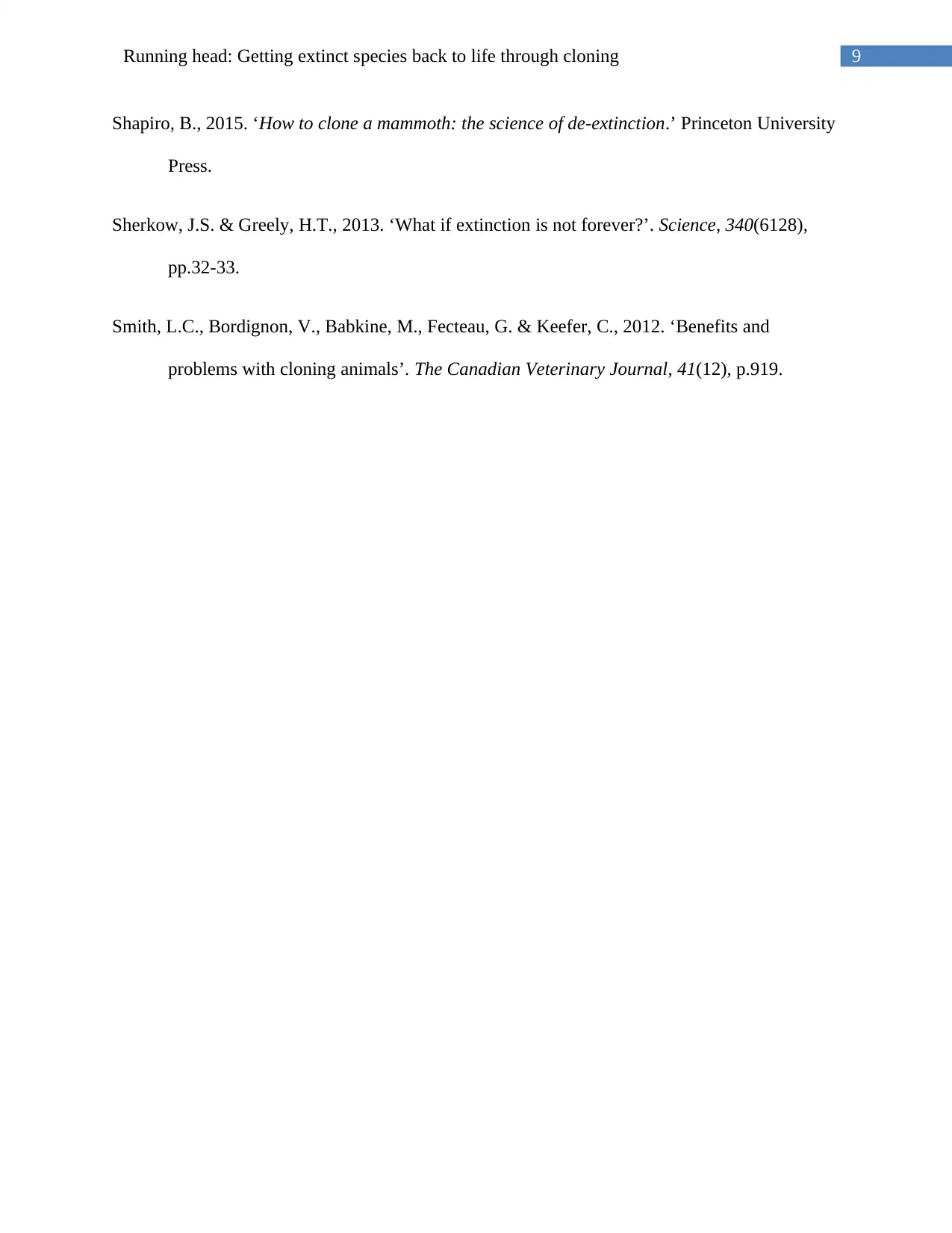
9Running head: Getting extinct species back to life through cloning
Shapiro, B., 2015. ‘How to clone a mammoth: the science of de-extinction.’ Princeton University
Press.
Sherkow, J.S. & Greely, H.T., 2013. ‘What if extinction is not forever?’. Science, 340(6128),
pp.32-33.
Smith, L.C., Bordignon, V., Babkine, M., Fecteau, G. & Keefer, C., 2012. ‘Benefits and
problems with cloning animals’. The Canadian Veterinary Journal, 41(12), p.919.
Shapiro, B., 2015. ‘How to clone a mammoth: the science of de-extinction.’ Princeton University
Press.
Sherkow, J.S. & Greely, H.T., 2013. ‘What if extinction is not forever?’. Science, 340(6128),
pp.32-33.
Smith, L.C., Bordignon, V., Babkine, M., Fecteau, G. & Keefer, C., 2012. ‘Benefits and
problems with cloning animals’. The Canadian Veterinary Journal, 41(12), p.919.
1 out of 10
Related Documents
Your All-in-One AI-Powered Toolkit for Academic Success.
+13062052269
info@desklib.com
Available 24*7 on WhatsApp / Email
![[object Object]](/_next/static/media/star-bottom.7253800d.svg)
Unlock your academic potential
© 2024 | Zucol Services PVT LTD | All rights reserved.





